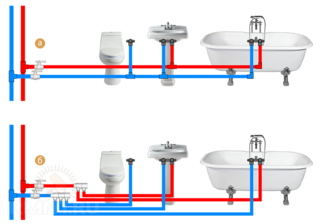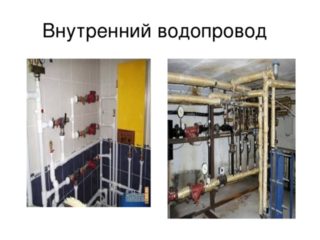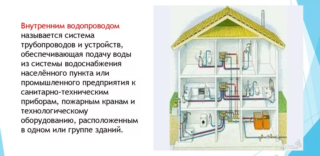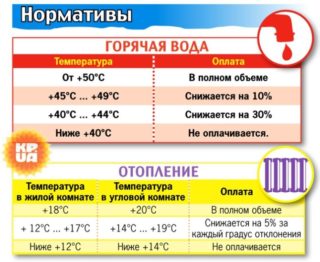Water supply refers to life support systems, without which office buildings, enterprises, and residential buildings cannot function. The efficient distribution of water inside the structure makes it comfortable, safe and environmentally friendly.
Definition and purpose of the internal water supply system
It is not allowed to connect a drinking water pipeline with a water supply network that supplies industrial water that is not suitable for drinking.
The internal water supply system provides water for household plumbing, technological, and fire-fighting equipment. It is supplied from the central water supply of the settlement, or from a separate well or a natural source. The type of internal water supply is influenced by technical capabilities, sanitary and hygienic and fire safety requirements, as well as the economic feasibility of the project.
Requirements for internal water supply systems
- equipped with devices for measuring the volume of consumed liquid;
- equipped with devices for monitoring and regulating the pressure in the system;
- materials for water pipes must be environmentally friendly and chemically inert;
- drinking water to meet sanitary and hygienic standards goes through several stages of purification, clarification;
- liquid from the technical water pipeline is not used for drinking, but goes through the purification stages necessary for the technological process;
- to optimize plumbing systems, they are combined as much as possible, which reduces operating costs.
Reliability of operation is ensured by the simultaneous laying of two lines of the water conduit with switches between them, so that one of the pipes can be repaired or changed without interrupting the water supply.
To ensure uninterrupted supply with one thread of the water supply, storage tanks are provided.
The temperature of hot water in the utility pipe should not be lower than 50-60 degrees to prevent the development of microorganisms. But should not exceed 75 degrees for consumer safety. For example, in children's institutions the temperature of the hot water supply system is reduced to 37 degrees
The minimum free head of the internal water supply in a one-story building should be 10 m, in multi-story buildings, an increase of 4 m per floor is provided.
Internal water supply maintains microbiological characteristics. Drinking water should be free of microorganisms and their metabolic products, the regulated coli-index (the number of E. coli in 1 kg of water) is not more than 3.
Types and device
- industrial - supply water to workshops at industrial enterprises;
- household and drinking water - supply drinking water to residential buildings or to workers in production;
- fire-fighting - provide water during fires.
It is possible to combine all water supply systems in one industrial-drinking-fire water line. It is expensive if you have to spend a lot of clean water on production needs. More often, an economic and fire-fighting water supply system is created using drinking water.
According to the method of transporting liquid, water lines:
- gravity;
- with spare tanks;
- with booster pumps;
- combined.
The design features and composition of the internal water supply system depend on the required quality and volume of fluid in a residential building or industrial building. The basic device includes:
- input, one or more;
- water meter unit: counter;
- technological equipment for increasing the pressure: pumps for supply to the upper floors;
- valves: shut-off, safety, control, mixing;
- connecting elements for installation of pipes: elbows, adapters, fittings, squeegees;
- distributing horizontal pipe network;
- vertical risers with connections to the plumbing equipment of consumers;
- spare containers.
Sometimes devices are provided for additional cleaning, deferrization, softening, degassing, or disinfection.
The hot water supply system is organized similarly to cold water, a feature is the need for thermal insulation of pipes passing through the building in order to prevent premature cooling. According to the way of organization, internal hot water supply systems are circular or dead-end.
Internal network design
Providing the necessary pressure of drinking or service water at the consumer using pipes of a minimum length is the main task of designing an internal water supply.
Internal plumbing fits into the interior of buildings or premises without disturbing the design and basic structure. Consider the following:
- Calculations are based on the maximum amount of water consumed per unit of time (1 second).
- The flow rate in the internal water conduit pipes, including the fire-prevention one, is not more than 3 m / s.
- If there are two inputs, each of them is calculated at 100% load in order to ensure uninterrupted supply one at a time when the other is disconnected. If there are more inputs, the liquid consumption is 50%.
- The internal water supply is laid from pipes, the diameter of which makes it possible to effectively use the pressure of the external water supply at the highest water consumption in the building.
- The diameter of the pipes of the ringing lintels corresponds to the largest diameter of the pipes of the standpipe.
- Provides for the device of vibration-insulating bases for pumping units.
- In apartment buildings or public buildings, the most hidden laying of internal water supply networks is carried out in rooms with a temperature of at least 2 degrees. Technical basements, attics, underground channels of engineering communications are used.
In difficult cases, the design of an internal water supply system, hydraulic calculations, and the determination of equipment parameters are carried out by specialists taking into account the requirements of SNiP 2.04.01-85 *.
Basic installation schemes

Installation of internal water supply systems is carried out according to the schemes:
- Bottom piping without water pumping devices. Installed in the basement. The pressure in the internal network is provided by the pressure of the external water supply system.
- Bottom piping with booster pump. Installed in the basement. The pressure is generated by a pump.
- Top piping with storage tank. Installed in the attic or on the technical floor. The pressure is created by a water tank.
- Ring diagram.It is installed if the system has two or more inputs for uninterrupted water supply: in residential buildings, where there are more than 400 apartments; public buildings visited by a large number of people (theaters, clubs, cinemas, baths); when installing simultaneously 12 or more fire hydrants.
The installation of a water supply system is done by employees of specialized organizations in different ways: in bulk - assembly of parts and devices on site, used for individual projects; blocks - for standard building projects; sanitary cabins, where the main pipes are installed at the plant - used in large-panel housing construction.












